Surprise, surprise, surprise. I've actually been writing about how unimportant the rider's seat and legs are for a long time but it may have gotten lost in the shuffle. So, here's a visual to help things along.
Got that freshly burned in your mind? Good.
Now, let's go back to what has probably got you up in arms a little bit. You know what I mean, the how dare I say the rider's seat and legs aren't important?! part.
The order of physical aids goes in the following order of importance:
- Hands
- Legs
- Seat
- Weight
Whoa there little bessie! Everyone knows the rider's seat is numero uno when it comes to Dressage.
Well, yes and no.
All of the physical aids are important, but the order is based on their ability to influence the horse.
Think about it this way: the physical aids are how you translate what it is you want to your horse. You can't tell him in plain English so you have to convey it to him through some other means. I'm skipping over voice cues and non-physical body language right now to help keep things simple.
If you have a horse who's never been ridden, do you expect him to understand clearly what you want him to do when you adjust your seat? No. Do you expect him to understand the subtlety of a weight aid except recognizing when you're making it easier or more difficult for him to carry his rider? No. Do you expect him to know what you want when you squeeze your legs? No.
He doesn't immediately know what our reins mean either, but it's the one physical aid that applies to your horse when you're leading, lunging, long-reining, driving and riding.
I mean really, are you going to teach him leg aids from the ground by booting him on his barrel? I didn't think so.
How unimportant are the rider's seat and legs?
The seat and legs are vital when riding. They're important, but they take a back seat to the hand since they can only be applied when you're riding your horse. He learns to recognize their aids through the initial help of the hand; whether it's a person on the ground lunging you while you teach him to move forward from the seat, or you applying a half-halt moments before adjusting your seat to cue for a flying lead change.
In the beginning though, your seat and legs should play a more passive role by supporting a balanced position in the saddle. This way you ensure your hands have a solid support to be light and refined; and you're not balancing on the horse's mouth, death-gripping his sides, or flopping about in the saddle like a sack of potatoes.
Easy in theory, difficult in practice
You should be practicing the handling of the reins regularly, and constantly when possible. Learning to be tactful and light, soft yet intentional. Try to make every action a conscious decision – it's tough! The more you practice the better you will become, and the possibilities become endless.
Practice lengthening and shortening your reins, smoothly and without disturbing your horse. If he slows down when you're shortening the reins you might need to go slower. If he speeds up while you lengthen your reins you might need to go slower as well. Practice holding the reins in one hand, then the other, and practice changing hands without pulling on the reins or disturbing his mouth. Practice lengthening and shortening the reins while holding them in one hand – use your free hand to help instead of crawling up the reins with your fingers.
One-tempi flying changes just from the hand are completely possible.
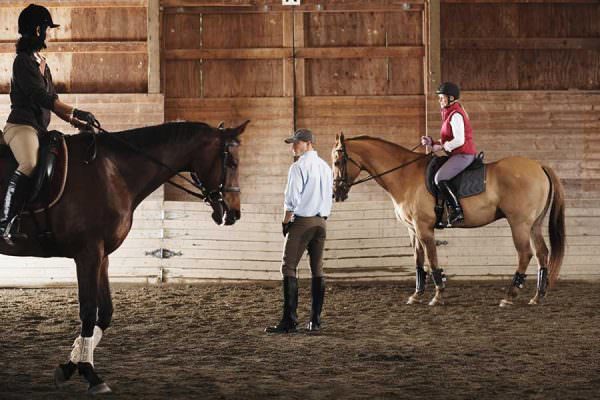
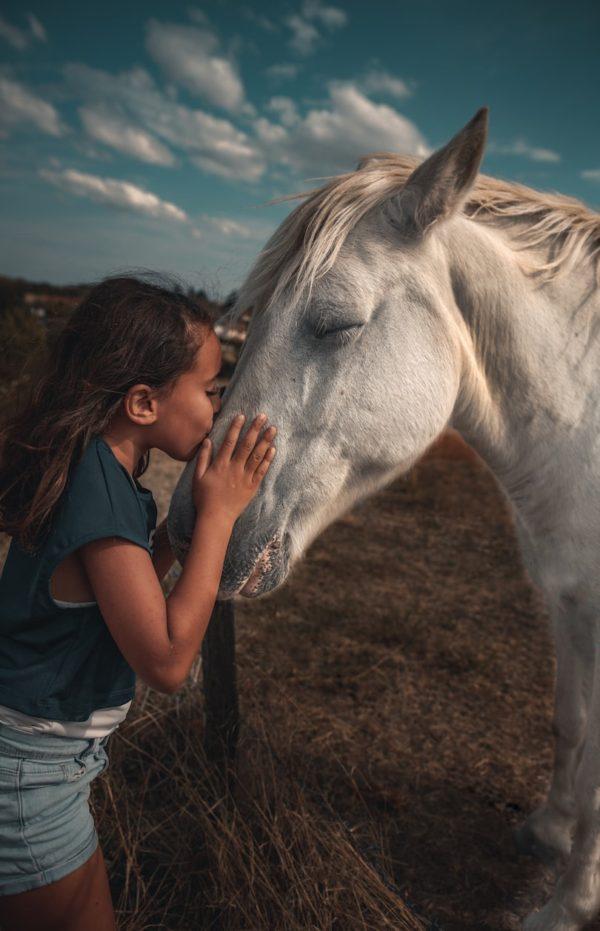
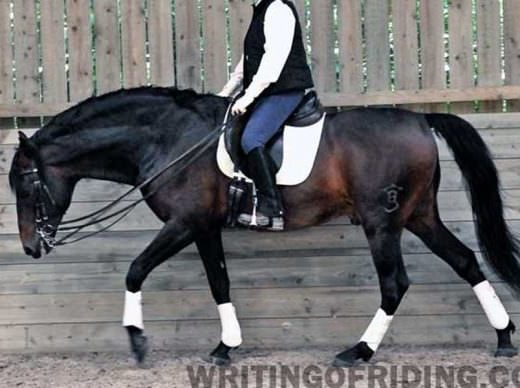
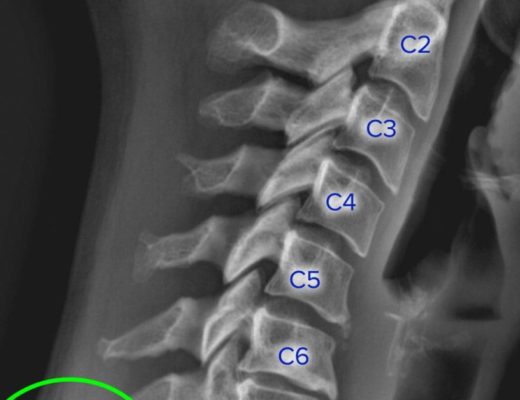
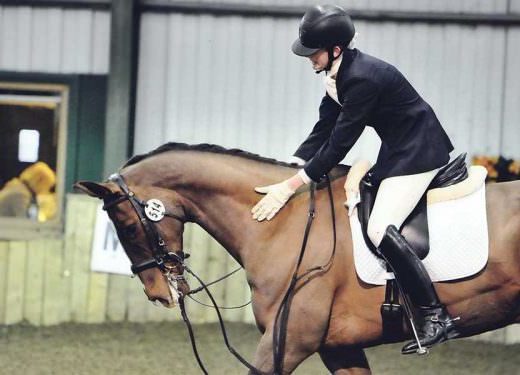
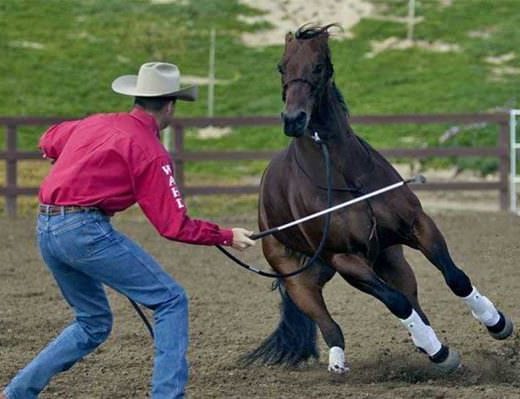
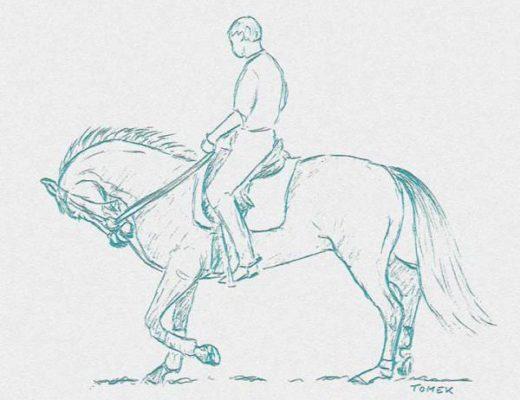
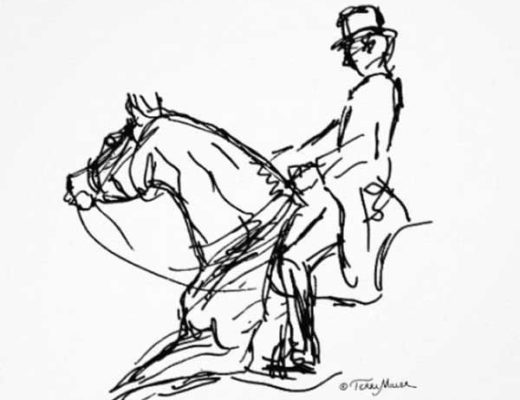
I actually don’t agree completely.
My experience is that the seat and change of weight is more logical for an uneducated horse then hand- or leg cues. Unless you’re trying to teach them to react opposite of their instinct (which is the case when you’re teaching them to react to the rein, it is more natural to lean against the pressure). An example; if you shift your weight to the inner back leg or outside front leg the horse will move towards a travers. Because their natural reaction is to step under the point of weight for better support and balance. Legs and reins are aids you have to teach them how to react to, seat and weight changes are not.
In my training, seat and weight are the primal aids. Legs and reins are secondary aids – what you use carefully when the primal aids are not sufficient. I have never had as many aha-experiences as when I attended a clinic that only focused on seat and weight. As long as you are relaxed and aware of your body it is very easy to influence the horse, the secondary aids are unnecessary more often then you’d think – they might also ruin a lot, because they more easily can become too ”intense”.
I would say that all horses react to subtle changes in the seat as long as they have not taught themselves to ignore it. That can easily happen with the wrong rider, but the same can happen with hand and leg cues.
I saw that you liked Bent Branderup, which is the way I train (academic art of riding) my horses, so I would also like to add this photo; http://u.jimdo.com/www31/o/se858a71539d6b25e/img/i270ce78264f1c7e7/1353272349/std/image.jpg
🙂
ha, you’re welcome to disagree – it’s excellent to open discussion! 🙂
I do agree that the seat and weight are very, very important aids. However, there’s a difference between an uneducated horse who’s been under saddle a time, and a horse you’re sitting on for the first moments. How do you translate to that horse what your seat and weight and legs mean without some influence from the hand – whether it’s yours or the hand of someone from the ground? And in the uneducated horse who ignores or misunderstands your seat or weight aid, how do you reinforce or clarify it?
Have you seen Branderup starting horses? I’d be curious to know how he goes about it and starts their under saddle education – that’s always something I wish more equestrians would make public because it’s almost a mysteriously secreted process and it shouldn’t have to be, imo.
And I agree the hands are overused, as are the legs. I’d love to see the education of the hands and legs more mainstreamed within general horse-riding instruction.
Do you know if Branderup is planning to release a translated version of his book? I’d love to recommend it to more people. 🙂
Don’t agree with the progression of aids at all. Many things are done with a green horse with the goal of legs and seat ultimately becoming the predominant aids.
We can’t be saying no to rolkur in one breathe and then writing an article like this.
The art of riding and schooling comes down to balance and give and take reward with our aids. If there is no reward or moments of self carriage than we are just gnats pestering our horses and not moving them to that higher level if training. JMO
Yes, the legs and seat are what we wish to progress to, that’s what I pointed out in the article. But to get there we start with the hand, and it’s important that we spend a gross amount of effort improving our skills with the hand.
Just wondering what the rider in the red vest is trying to do in the picture above ? Nice picture of the instructor though !
They both look a little confused. 🙂
Yes, legs and reins to reinforce – but seat and weight is the most important aids no matter what. Like I said, my experience is that seat and weight does not need translating – we use the horses natural reaction to get the answer we want. It’s easier for a young horse to understand those two aids (because their natural response is correct) then legs and reins because in those two they have to learn an unnatural response.
Yes, I have seen him and other AR-trainers starting young horses. It usually goes like this; Starting with groundwork. Here the horse will learn how to respond to the hand and legs (using a whip or your hand as a ”leg”). When you introduce the rider, someone will be longing the horse, giving it time to find balance with a person on it’s back. Later the rider can start to influence the horse through the seat, then the legs and reins.
A horse that has not been ”broken” (learned to ignore the seat) will always respond to shifting weight, etc. Never seen a horse that doesn’t. It might not respond enough for a lot of people to notice it, that’s the only problem. You also have to remember praising every single little step, so that the horse is comfortable with giving suggestions and trust their instinct. 🙂
If the horse misunderstands the seat, the first step is to try to clarify it – but that doesn’t have to be with legs and reins. Most likely the horse will understand the question if you ask in a different way, but even more likely – you did something wrong. Try to figure out what, and try again. The legs and reins can also reinforce, but most of the time it’s unnecessary – which is why I don’t think that they are the most important aids.
I probably should mention that I don’t train for Branderup myself even though I have attended his clinics without a horse, but Monika Müller – mostly the same, but there is some differences among the trainers.
It’s a bit difficult for me to explain because I’m not used to ”horse terms” in english… 🙂
Have you seen his videoes? You can buy them on his website and stream them whenever you like (and share with others if they use your log-in). Maybe ”Diary of Swan” is interesting for you? It’s following Swans education from start to finish (maybe not finish, but where he is now). http://www.youtube.com/watch?v=JEGfcERkLJY I think it’s about an hour long.
I just bought the new book (it’s the same as the old one but updated a bit) in english. Haven’t read the whole thing yet, but so far it’s great! Don’t think they send to USA from where I bought it, but I found it here (I think it’s an english version…); http://www.bookdepository.com/Academic-Art-Riding-Bent-Branderup/9780857880154
Elizabeth,
Ah, that is probably where we are disconnecting with one another – having to train the horse to do the opposite of his nature with the rein, and leg, aids.
If you train your horse to go forward when you squeeze with the legs, it’s a great example of having to teach the horse to do the opposite of his nature. The pressure of the legs to a young horse elicit him to contract through the barrel instead of expand, enough pressure applied and it isn’t surprising to see the horse react by bucking, rearing or balking – all actions which lack forward energy and relaxation through the barrel.
My personal preference is to teach the horse to move forwards with the release of pressure and to slow as the legs increase contact and pressure. And with the hands, to encourage the horse to reach out for contact when contact is initiated. To yield as contact is released. Both of these are more in alignment with the horse’s natural responses.
But.. then you have to teach the horse both ways anyhow if you wish them to be a riding horse by anyone who is riding in the normally taught fashion – pressure means go with the legs, pressure means stop with the reins.
If you ride with the horse’s nature from the beginning with the hand and leg aids there is nothing to un-teach with those aids.
Yes, I’ve seen his videos, it’s really fantastic they’re made available. And thank you for the link to the book, I’ll check it out this weekend and share it around!
Cheers,
Erica
Still don’t think you understand me, and that’s not where we’re disconnecting…
In AR we also use a different type of leg cue then in ”ordinary dressage”. It is only used at the exact point in movement when you are able to influence without creating too much pressure. That’s why we never use both legs at the same time (it has to follow the swinging of the back). Instead of using a leg cue to make the horse yield we want the leg to mean ”step with this specific hindquarter more towards your centre of gravity”. The legs are not used for higher tempo (that’s controlled with the seat – or sometimes voice, etc) – but the lower leg can be used for slower/faster ”takt” (don’t know the english word).
That’s a digression… But the point is that as soon as you use your legs or hands you are creating pressure. It might not be much pressure, but that is still what it is (unless you’re not actually touching the horse at all..). You can teach the horse that when I apply this pressure (or after I release) I would like you to yield, go faster, slow down, what ever… And even though some of those things is more logical then others, the horse has to understand that there is no need to be tense or press back – because that is their natural reaction to all sorts of on-the-body-pressure (not their reaction to ”pressure” from a distance though – like when horses use their body language to move others by claiming their space).
Here’s where seat and weight is different. A correct seat that follows the horses movement will more likely be able to influence without creating pressure or tension – just because you don’t apply any pressure yourself, you’re just shifting your weight, etc.
I would still say that the seat is by far the most important aid. Legs and reins are the secondary aids, the ones you use when you’re seat is not educated enough to give a clear and understandable message.
You’re welcome, I’m sure you will like it. 🙂
I can see all points on this debate and while I don’t agree that the hands are more important than the seat and legs, I do think more riders should spend time working on their hands and rein technique, myself included. I worry that stating that ‘your seat and legs aren’t important’ might encourage riders to focus too heavily on riding from the reins – which is where many problems start. For riders, the hands should come last on the scale of learning – only after achieving a good seat and effective, independent leg aids, can we even hope to achieve the level of finesse in rein contact that classical riding requires.
With regards to training young horses, I think all the above methods have their place, but it’s important that we are open minded enough to adjust due to the individual horse not just follow one strict training method. I’ve ridden horses that seem extremely sensitive to leg and weight aids from the start and have used this to my advantage, bringing in rein aids later; conversely, I’ve ridden horses that seemed very unbalanced by any shift in weight to begin with, who were best ridden by a very quiet, balanced rider using only rein aids until they began to find their balance. The same is true when continuing training – I’ve ridden horses who were incredibly light and responsive to rein aids, while others who were a little resistant to the contact rode better supported by leg and weight aids (of course, much of this is down to the initial training of the horse, but not all of us will have the privilege of training our own horses). It’s great to have a discussion about the ‘ideals’ of training, but we have to remember that no horse or rider is perfect and it shouldn’t be about a ‘right’ or ‘wrong’ way – only what’s best for the individual horse and rider.
Very very interesting article and ensuing debate! I particularly agree with the last comment: